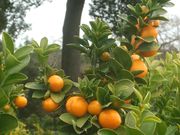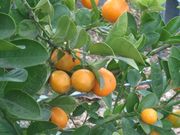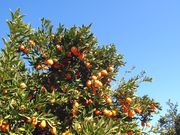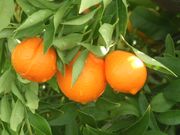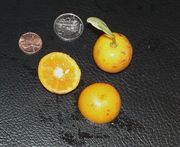|
|||||||||
Select any of 50 available languages! |
|||||||||
Kumquats and kumquat hybrids
Citrus japonica Thunb.
(formerly Fortunella Swingle)
| History Today Description Uses and nutritional values Distribution Marumi
Kumquat (Round Kumquat)
Meiwa Kumquat (Sweet Kumquat) Hong Kong Kumquat Fukushu Kumquat (Changshou Kumquat) Malayan Kumquat Kumquat hybrids Sunquat (Lemonquat) Mandarinquat 'Indio' Mandarinquat 'Nippon' Limequat Citrus × floridana Limequat 'Eustis' Faustrime Limequat 'Lakeland' Limequat 'Tavares' Citrangequat Citrus × georgiana Citrangequat 'Thomasville' Citrangequat 'Sinton' Calamondin Calamondin 'Peters' Australian Sunrise Lime Citrus × oliveri |
|
| 'Fukushu'
kumquat © Jorma Koskinen |
|
History
and earlier classification
Description
Distribution
|
|||||||||||||||||||||||||||||||||||||||||||||||||||||||||||||||||||||||||||||||||||||||||||||||||||||||||||||||||||||||||||||||||||||||||||||||||||||||||||||||||||||||||
| LAT | Citrus japonica Thunb. 'Marumi' |   |
| Syn | Fortunella
japonica (Thunb.)
Swingle |
|
Marumi is the Mame or Hime kinkan of Japan. In comparison with the Nagami kumquat, which it closely resembles, the fruit of this kumquat is round or slightly oblate, oblate, sometimes obovate, and smaller. The rind is thinner and somewhat sweeter, golden-yellow smooth with a wider range in the number of segments (four to seven) and 1 to 3 seeds, which are smaller than those of Nagami. The tree is less vigorous and somewhat thorny, with smaller, less sharply pointed leaves. It is considerably more cold tolerant than Nagami and bears at the same season, from October to January. The Round kumquat was fully described for the first time in 1784. It was introduced to Florida from Japan by Glen St. Mary and Royal Palm nurseries in 1885. |
||
| ENG | Marumi kumquat, Round kumquat, Sweet-peeled kumquat | |
| FIN |
pallerokumkvatti |
|
| FRA | Kumquat Marumi, kumquat rond, kumquat du Japon | |
| DEU | Marumi-Kumquat, Rundkumquat | |
| I TA | kumquat rotondo, kumquat a frutto rondo | |
| ESP | kumquat redondo, naranjita japonesa | |
| Photos | © Petr Broža © Sylvia Svensson |
|
| |
||
| LAT | Citrus japonica Thunb. 'Meiwa' | 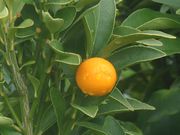 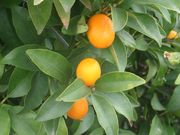  |
| Syn | Fortunella crassifolia Swingle Citrus japonica (Thunb.) 'Nagami' × Citrus japonica Thunb 'Marumi' |
|
Meiwa kumquat is thought to be a natural hybrid between the oval (Nagami) and round (Marumi) kumquats. This species is the Ninpo, Meiwa or Neiha kinkan of Japan. The most distinctive features of this kumquat are the short oblong or round form and relatively large size of the fruit, the more numerous sections (commonly seven), the very thick and sweet rind and comparatively sweet flavour, and the low seed content. Many fruits are seedless. This is much the best kumquat variety for eating fresh. Although slightly less cold-hardy than Nagami it is increasing in popularity. Meiwa was introduced from Japan between 1910 and 1912. The tree is a dwarf, frequently thornless or having short, stout spines; the leaves differ from those of other kumquats in being very thick and rigid and partly folded lengthwise; they are pitted with numerous dark-green oil glands. |
||
| ENG | Meiwa kumquat, Large round kumquat, Sweet kumquat | |
| FIN |
makeakumkvati |
|
| FRA | Kumquat Meïwa, kumquat doux | |
| DEU |
Meiwa-Kumquat |
|
| I TA | meiwa kumquat | |
| Photos | © Jorma Koskinen | |
| |
|
|
Kumquat hybrids
| LAT | Citrus × floridana (J. Ingram & H. Moore) Mabb. Limequat |  Limequat 'Eustis'  Limequat 'Tavares' |
| Syn | XCitrofortunella floridana J. W. Ingram & H. E. Moore XCitrofortunella swinglei J. W. Ingram & H. E. Moore |
|
Limequats are Mexican lime x kumquat hybrids made by Dr. Swingle in 1909, described and named in 1913. Trees are vigorous, evergreen, the single leaflets having narrowly-winged petioles; nearly spineless or with a few short thorns; more cold-tolerant than the lime but not as hardy as the kumquat; very resistant to wither tip. Fruit much like the Mexican lime. There are three named cultivars: Eustis, Lakeland, and Tavares (see below), important in approximately that order. All are characterized by fruits that closely resemble the West Indian lime in size, form, and composition and hence are reasonably acceptable substitutes. Eustis and Lakeland also closely approach the West Indian lime in colour. Tavares, however, exhibits some of the orange colouration characteristic of the kumquat and the pink of the flower buds, which occurs in the West Indian lime. All limequats are more cold-resistant than the lime parent but much less so than the kumquat. None of the limequats has achieved commercial importance for the fruit, but Eustis and Lakeland are grown to some extent as ornamentals. In California, they are popular as potted or tubbed plants for patios and terraces. Eustis and Lakeland are sister hybrids of the West Indian lime and the round kumquat (Marumi), and Tavares is a similar hybrid with the oval kumquat (Nagami). |
||
| ENG | Limequat |
|
| FIN |
limekvatti |
|
| FRA | ||
| Photos | © Jorma Koskinen | |
| |
||
| LAT | Citrus × floridana (J. Ingram & H. Moore) Mabb. 'Eustis' |     |
| Syn | XCitrofortunella 'Limequat Eustis' Citrus aurantiifolia (Christm. et Panz.) Swingle × Citrus japonica Thunb. 'Marumi' |
|
| Eustis Limequat is a Mexican lime crossed with Round kumquat; oval or round, 1 1/8 to 1 1/2 in (2.8-4 cm) wide; peel pale-yellow, smooth, glossy, with prominent oil glands, thin, edible; pulp light greenish in 6 to 9 segments, tender, juicy, very acid, with 5 to 12 small seeds. Of excellent quality, nearly ever-bearing but mainly in fall-to-winter. Tree has small spines and pure-white buds and flowers; prolific. |
||
| ENG | Eustis
Limequat |
|
| FIN |
limekvatti 'Eustis' |
|
| FRA | ||
| Photos | (1) © Laaz (2-3) © Jorma Koskinen (4) © Joe Real |
|
| |
|
|
| LAT | Faustrime |  |
| Syn | Citrus × floridana (J. Ingram & H. Moore) Mabb. 'Eustis' × Citrus australasica F.Muell. |
|
Faustrime is a hybrid of Limequat Eustis and the Australian fingerlime (Microcitrus australasica). It is discussed in >> Native Australian citrus varieties. Disambiguation: Faustrimedin |
||
| ENG | Faustrime |
|
| FIN |
sormilimekvatti |
|
| Photo | © Laaz | |
| |
||
| LAT | Citrus × floridana (J. Ingram & H. Moore) Mabb. 'Lakeland' |  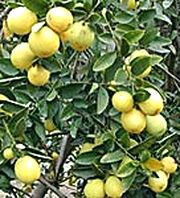 |
| Syn | XCitrofortunella 'Limequat Lakeland' Citrus aurantiifolia (Christm. et Panz.) Swingle × Citrus japonica Thunb. 'Marumi' |
|
Lakeland limequat is also a Mexican lime crossed with round kumquat, but a different seed from the same hybrid parent. The fruit is oval, 1 1/4 to 2 1/4 in (4.5-7 cm) wide; peel bright-yellow, smooth, thin; pulp in 5 to 8 segments, pale-yellow, juicy, pleasantly acid, with 2 to 9 large seeds. Yellow-orange fruit on bushes three feet tall; highly productive. Tree nearly spineless; flowers white with pink streaks. |
||
| ENG | Lakeland
Limequat |
|
| FIN | limekvatti
'Lakeland' |
|
| Photos | © Plantes du sud © Brazos Citrus Nursery |
|
| |
||
| LAT | Citrus × floridana (J. Ingram & H. Moore) Mabb. 'Tavares' |   |
| Syn | XCitrofortunella 'Limequat Tavares' Citrus aurantiifolia (Christm. et Panz.) Swingle × Citrus japonica Thunb. 'Nagami' |
|
Tavares limequat is a Mexican lime x oval kumquat hybrid; obovate to oval, about 1 1/4 to 1 7/8 in (3.2-4.75 cm) wide; peel pale orange-yellow, smooth, thin, tender, edible; pulp buff-yellow, in 7 to 8 segments, juicy, very acid, with 6 to 11 large seeds. Tree is vigorous with short spines and pink flower buds. |
||
| ENG | Tavares
Limequat |
|
| FIN | limekvatti 'Tavares' | |
| Photos | © Jorma Koskinen | |
| |
|
|
| LAT | Citrus × georgiana Mabb. 'Citrangequat' |  'Four Seasons' citrangequat  'Macciaroli' citrangequat |
| Syn | Citrus japonica Thunb. 'Nagami' × (Citrus × insitorum Mabb.) Citrus japonica Thunb. × [(Citrus × sinensis (L.) Osbeck) × Citrus trifoliata L.)] Nagami kumquat × Citrange |
|
Combining the cold-hardiness of the kumquat and trifoliate orange, the citrangequats appear to be more cold-resistant than the citranges or the Calamondin and kumquat, for they are said to succeed in regions too cold for these fruits. The first crosses were made by Dr. Swingle at Eustis, Florida, in 1909. Tree is vigorous, erect, thorny or thornless, with mostly trifoliate leaves; highly cold-resistant. Fruit resembles the oval kumquat, mostly very acid. Two varieties are described below. Both produce fruits with marked resemblances to the kumquat. One is characterized by a high percentage of trifoliate leaves, the other by mainly unifoliolate leaves. |
||
| ENG | Citrangequat |
|
| FIN |
kolmilehtikumkvatti |
|
| FRA | Citrangequat | |
| Photo | The
picture of the 'Four Seasons' variety is from SRA/INRA Corsica The 'Macciaroli' grows in the Gene Lester citrus collection. |
(1) © C. Jacquemond
/ INRA (2) © Jorma Koskinen |
| |
||
| LAT | Citrus × georgiana Mabb. Citrangequat 'Thomasville' |    |
| Syn | Citrus × insitorum Mabb × Fortunella margarita |
|
Thomasville becomes edible when fully mature, though it is relatively seedy. It is very juicy, valued for eating fresh, for marmalade and for flavouring soft drinks. The tree is strongly resistant to citrus canker and is very ornamental. Citrangequat Thomasville is an Oval kumquat and Willits citrange hybrid and was first fruited at Thomasville, Georgia. The cross was made in 1909, and the variety was named and described in 1923. Fruit medium-small, globose to oval; colour yellow to orange-yellow. The tree is very vigorous, upright and thorny. Leaves are variable but mainly trifoliate. Presumably because of the larger size and edibility of the fruit, it is much the most popular citrangequat variety. |
||
| ENG | Thomasville
citrangequat |
|
| FIN |
kolmilehtikumkvatti
'Thomasville' |
|
| FRA | Citrangequat Thomasville | |
| Photos | (1-2) © Jorma Koskinen (3) © Gene Lester |
|
| Links | Home Citrus Growers | |
| LAT | Citrus × georgiana Mabb. Citrangequat 'Sinton' |   |
| Syn | Citrus × insitorum Mabb 'Rusk' × Fortunella margarita |
|
Citrangequat Sinton is an Oval kumquat and Rusk citrange hybrid first fruited at Sinton, Texas, and was named and described in 1923. It is an attractive ornamental and the fruit is beautifully coloured but highly acid. Fruit is small, round to oval; often necked; colour deep reddish orange; sharply acid; nearly seedless. Tree moderately vigorous, upright, nearly thornless; leaves mainly unifoliolate. |
||
| ENG | Sinton
citrangequat |
|
| FIN |
kolmilehtikumkvatti
'Sinton' |
|
| FRA | Citrangequat Sinton | |
| Photo | © Jorma Koskinen | |
| Links | ||
| LAT | Citrus × microcarpa Bunge Calamondin |    |
| Syn | XCitrofortunella microcarpa (Bunge) Wijnands XCitrofortunella mitis J. Ingram & H. E. Moore Citrus mitis Blanco Citrus madurensis Loureiro Fortunella japonica Thunb. ' Nagami' × Citrus sunki Tanaka |
|
Calamondin is a kumquat hybrid most likely of Chinese origin but introduced to the western world from the Philippines. More has been written about the correct classification and origin of the Calamondin than most other citrus plants. The exact hybrid nature of the Calamondin remains to be established. It is commonly accepted to be a hybrid of a sour mandarin type and a kumquat. The most frequently mentioned candidates are the Sour mandarin Citrus sunki Tanaka of 1927 (which is the later Citrus reticulata var. austera of Swingle of 1942) and the Oval or 'Nagami' kumquat Citrus japonica Thunb. It is still unclear to which plant the classification Citrus madurensis by Loureiro (1717-1791) referred to. Blanco created Citrus mitis in 1837. J.Ingram & H.E.Moore used the name X Citrofortunella mitis in 1975 and the name Citrofortunella × microcarpa was given by Wijnands in 1984. The last two are obvious attempts to acknowledge the hybrid nature of the Calamondin Citrofortunella suggesting both the genus Citrus of the mandarin parent and the genus Fortunella of kumquats. So far the hybrid genus Citrofortunella has not been accepted as a valid name. As the genus Fortunella of Swingle is no longer valid either (see History and Today) the concept has no basis. The oldest documented description and classification is valid today and it was given to the Calamondin by Alexander Andrejewitsch von Bunge (1803-1890) as Citrus microcarpa Bunge in 1833. When a plant is obviously of a hybrid nature the sign × is today attached between the genus and species name. Since 1997 Citrus × microcarpa Bunge has been the legal classification of the Calamondin. The × sign is only added in writing, it is not pronounced. To type it press down and hold Alt-key, type 0215 on the numeric key pad, release Atl-key. While the Calamondin is a cross between the Sour mandarin (Citrus sunki) and the Oval Kumquat (Citrus japonica Thunb. 'Nagami') it is itself a parent in many other hybrids, Faustrimedin among them (Citrus × microcarpa Bunge × Citrus australasica F.Muell.). Calamondin has inherited more qualities from the mandarin than the kumquat. Whereas the rind of kumquats is usually edible, the rind of Calamondin resembles those of the genus Citrus in being often too sour for consumption especially in the larger fruits (4 - 6 cm in diameter). The inner parts of the flower (pedicel and ovary) are also more like those of the Citrus. Calamondin can be used in the kitchen instead of lime. It was used in mixing drinks before lime became popular. It is good for marinating fish and in sauces for fish dishes. It is used in marmalades and jams. Calamondin can be pickled whole or in slices like cucumbers. The taste of Calamondin is best when it has fully matured. Calamondin is increasingly popular as a potted house plant. |
||
| ENG | Calamondin, Golden lime, Kalamansi lime, Panama orange, Musklime, Philippine lime | |
| FIN |
hapankvatti |
|
| FRA | Calamondin | |
| GER | Calamondine, Zwergapfelsine | |
| ESP | Calamondin, Lima de las Filipinas, Lemonsito | |
| Photos | (1)
© Joe Real (2) CCPP (3-4) © Jorma Koskinen |
|
| |
||
| LAT | Citrus × oliveri Mabb. 'Australian Sunrise Lime' |  |
| Syn | Faustrimedin Tanaka Citrus × microcarpa Bunge × Citrus australasica F.Muell. |
|
The Australian Sunrise Lime is an open pollinated seedling selected from a Faustrimedin, a hybrid of Calamondin (Citrus madurensis) and the Finger lime (Citrus australasica). Faustrimedin is discussed in >> Native Australian citrus varieties. Disambiguation: Faustrime |
||
| ENG | Australian
Sunrise Lime |
|
| FIN |
rusolimetti |
|
| Photo | © CSIRO Plant Industry | |
| |
||

|
|
Page up-dated 12 February 2011
Back to top of page



















